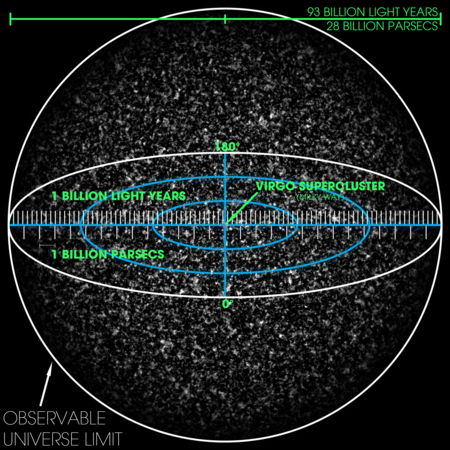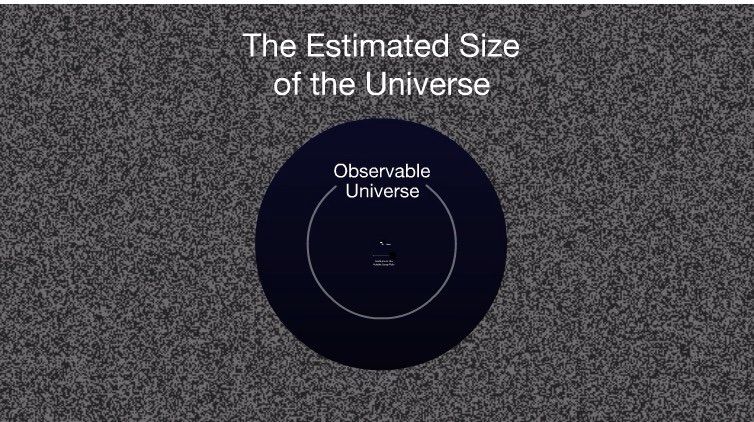THE SOUTHWORTH PLANETARIUM
207-780-4249 www.usm.maine.edu/planet
70 Falmouth Street Portland, Maine 04103
43.6667° N 70.2667° W
Altitude: 10 feet below sea level
Founded January 1970
Julian Date: 2459201.16
2020-2021: LXI
THE DAILY ASTRONOMER
Thursday, December 17, 2020
Remote Planetarium 134: The Observable Universe
____________________________________________
After the final quiz (part I on Friday, part II on Monday), the Remote Planetarium will draw to a close. However, as it is likely that the actual planetarium will remain shuttered into the early part of next year, the "Remote Planetarium" will be replaced by the "Exploratory Planetarium" that will. as its name suggests, explore as many regions of space-time as, well, time allows. The Exploratory Planetarium will begin its travels on January 4, 2021.
____________________________________________
In March we started with Earth's night sky.
We've now reached the edge of the observable Universe.

As its name implies, the observable universe encompasses everything that we can visibly see. The observable universe is a spherical region with an estimated diameter of 93 billion light years. Beyond its "membrane"exists the regions of the Universe beyond our vision. One might wonder: how can the observable universe be smaller than the actual Universe? Simple...well, somewhat simple. The answer pertains to the speed of light. We know the Universe is expanding and, according to recent discoveries related to dark matter, is accelerating in that expansion. Consequently, the remotest regions of the Universe are expanding faster than light speed. The light of the galaxies beyond the observable universe membrane hasn't yet reached us and so is blocked from our view. The entire extent of the Universe is unknown and, perhaps, will remain unknowable due to the continued universal acceleration.

The observable Universe, however, is sufficiently immense to keep us busy for a while. Within it we find more than a trillion galaxies and, most likely, hundreds of trillions -if not more- planets. Moreover, approximately 20,000 stars are born every single second. This prodigious star birth rate will also continue for billions of years. Meanwhile, galaxies will merge, the cosmos will grow and, as evidenced in our own small world, complexity will increase in various pockets despite the second law of thermodynamics which states that the Universe as a whole will tend toward a state of greater disorder.
Nothing here is truly comprehensible. As we are accustomed to being small creatures on a little planet around an average star, we can intellectually understand the extent of the cosmos, but cannot intuitively grasp the scale at which galaxies are reduced to minuscule points. Heavens, it is difficult to fathom something as massive as Earth, let alone a galactic supercluster.
If it is any consolation, when we begin our next series of excursions with the "Exploratory Planetarium," reality will become all the stranger.

Janus: Appearing at the beginning and at the end.
Janus appeared at the beginning of the Remote Planetarium in late March 2020. Now, he appears again at its conclusion. The Roman God of thresholds, beginnings and endings, Janus is depicted with two faces, each staring in a direction diametrically opposed to that of the other face. While one looks back at what has already transpired, the other looks ahead to what has not yet occurred. Consequently, Janus is regarded as both a melancholy god reflecting wistfully on what was and what might have been and as a joyous one who eagerly anticipates what shall be. The face that regards the past is the older of the two, its wizened visage indicative of the innumerable years that have already elapsed. The future-facing countenance is youthful and radiant, akin to the face of a young child whose happiness at the prospect of a promising future is unalloyed by the pains and traumas of a troubled life.
Unlike other gods, Janus does not interfere with the affairs of either mortals or Olympians. His role is simply to observe the world as it passes inexorably through time. Janus merely exists. It is incumbent on us to interpret him. Whereas a pessimist might perceive Janus as a god who looks toward a hopeful future that is merely destined to become a sorrowful past, an optimist could see him as a god who teaches us that we can draw wisdom from previous mistakes in order to create a better future. Perhaps he is encouraging us to simply remain calm: to accept that when we make any choice we simultaneously forego all the other possible choices and so we will all, at one time or another, contemplate the alternate life paths that go untraveled.
2020 is about to pass into the ages. Many people will not be sad to watch it go. Janus, as usual, will simply watch 2020 fade away as 2021 takes its place: the annual transition over which the god has presided since time began.
To subscribe or unsubscribe from the Daily Astronomer: